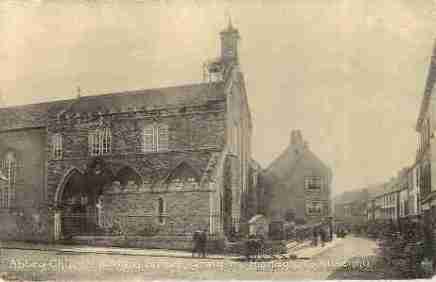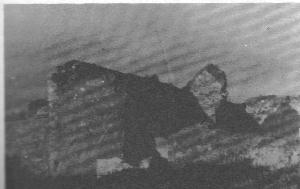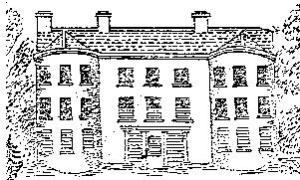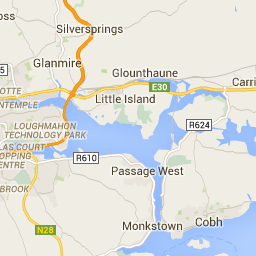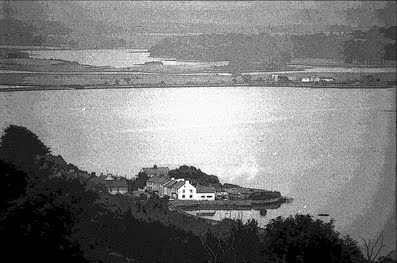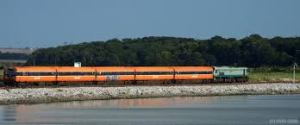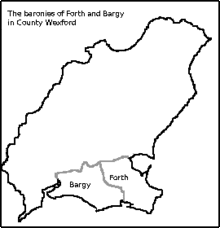It makes no sense to discuss the early history of Midleton without considering the older, and now overshadowed,neighbour, – the village of Ballinacorra. So I’d like to examine some aspects of Ballinacorra’s history here. I must acknowledge my debt to Paul MacCotter, who, as an excellent medieval historian, has presented so many insights into the history of the area around Midleton and Cloyne.

The Main Street of Ballinacorra around 1900. The building on the left might stand on the site of the mill recorded in 1301. The modern village looks very much as if it had been planned, and perhaps it was redeveloped in the later 1700s. Flowing under the road in the foreground is a culverted stream.
The village of Ballinacorra still retains its own identity despite being considered by many to be simply a suburb of Midleton. It is far enough away from Main Steet in Midleton to treat the larger town as an interloper. In the decades since the 1960s, the main road from Midleton to Ballinacorra has become built up, especially on the west side from Lakeview filling station (that’s a gas station to you Yanks!) to the Dark Road (‘dark’ because it was heavily shaded by trees). The eastern side of the road had just Lakeview Terrace and a couple of houses, along with Lakeview House itself. There were fields between the Presentation Convent boundary wall, which marked the southern end of Midleton town, and Lakeview filling station, and there are still fields on the eastern side between Lakeview House and the other houses on that side of the road. However, the building of ‘The Cotswolds’ (!) and ‘Castleredmond’ housing estates has filled in some of the open space. Charleston House still stands proudly isolated behind its high wall, trees and mercifully green fields on the western side of the road, directly opposite the entrance to the Castleredmond estate. Should the demand for housing boom again, it is likely that all the land bordering this road will be built up.

Ballinacorra Creek runs from the bottom left to the center right. The sharp straight end of the creek is the modern road from Midleton to Whitegate, cutting Ballincorra village off from its waterfront. The village proper lies byond the white line of the road. Ballinacorra house, with its adjacent farm buildings, lies at the bottom of the picture next to the creek. The strange bent wall visible at the bottom of the ploughed field, just above Ballinacorra House, draws the eye to the site of the medieval church, and the trees which surround and cover the mound that marks the Anglo-Norman motte or earthwork castle – Castranachore. The waterway coming in from the upper left is the estuary of the Owenacurra River, which flows through Midleton.
One important change in the road between Midleton and Ballinacorra was the rebuilding of that road since the 1950s – which entailed by-passing Ballinacorra and even filling in part of the waterfront thus cutting the village off from Ballinacorra Creek. This waterfront and its quays were the reason for the village’s whole existence in the first place. During the building of the Whitegate Oil Refinery in the 1950s, it was realised that the old road was inadequate and a narrow turn in the road at the top of the Main Street in Ballinacorra to Whitegate made it difficult to get large vehicles through the village. The solution therefore was to widen the road from Midleton to Whitegate, and it was necessary to by-pass Ballinacorra because the narrow Main Street was too constricted. Thus Ballinacorra became one of the first villages in Ireland to be by-passed. Today, when driving from Midleton to Whitegate on the R630, it is easy for the motorist to overlook the existence of the village because the road was laid out on a raised embankment which filled the eastern end of Ballinacurra Creek. This causeway was necessary because the road had to drop down a steep slope from Castleredmond, cross the Creek, and climb up the steep slope on the other side leading into Ballinacorra townland and continuing to Whitegate. In effect, Ballinacorra became lost in a hole, as well as being cut off from its historic waterfront by this wide, busy road and fast traffic. You get a better idea of the difficulties posed for the engineers when you turn off the main road into the village itself and drive up the Main Street to rejoin the main road further on.
As mentioned in my previous post, Ballinacorra is a much older settlement than Midleton. It was certainly extant in the middle of the twelfth century, and perhaps earlier. By 1160, the parish had been created as part of the organisation of the newly re-established diocese of Cloyne, the cathedral of which was just a few miles away (literally in the next parish!). It is likely that, as with Ballycotton, the site at Ballinacorra was developed as a port for Cloyne – indeed Ballinacorra was a much more secure port for shipping. Despite being located about nine nautical miles from the sea, Ballinacorra’s sheltered position, its proximity to Cloyne (compared with Ballycotton) and its access to the rich grain growing lands of the vale of Imokilly, made it a good spot for a port. The land may have been controlled by the Ui Mac Tire family – a bunch of parvenues who had recently usurped older ruling families to take over as the local lords of Ui Mo Caille or Imokilly. Imokilly is now a barony stretching from Midleton to Youghal and southwards to the sea. In the twelfth century only the western part of the modern barony from the present day Castlemartyr/Mogeely (& Ballymacoda?) line to Midleton and the eastern shore of Cork Harbour was called Imokilly, but it was later expanded to Youghal. Originally the barony included the territory stretching towards Carrigtohill, but these lands were incorporated into Barrymore well before 1500. Th original lands of Imokilly seem to have been controlled by the Ui Mac Tire in the north and the Bishop of Cloyne in the south.
The Ui Mac Tire were closely allied to the MacCarthy dynasty who ruled the kingdom of Cork or Desmond (South Munster). Indeed it likely that the MacCarthys re-established the diocese that had been extinguished at Rath Breasail. in 1111. They also seem to have been closely linked to the church reforms that had been in progress since 1111. Perhaps Cormac MacCarthy, the man who built Cormac’s Chapel on the Rock of Cashel, was the re-founder of the modern diocese of Cloyne! The MacCarthy kings were closely linked to the church reforms that were in progress in twelfth century Ireland, and their close allies the Ui Mac Tire may have followed suit. There’s an interesting German connection here that will be addressed in a later post!
The parish of Ballinacorra covered much of the area that was later covered by the civil parish of Midleton. A civil parish is effectively the medieval parish; today the civil parish provides the basis of Church of Ireland parish unions and is also of Roman Catholic parishes, although Catholic parishes might be drawn up to ignore civil parish boundaries. However, in 1180, the large parish of Ballinacorra was divided in two. The northern portion of the parish was given over as a separate parish to the Cistercians who settled at Chore on the site of today’s Midleton town. The southern portion of the original parish remained as the parish of Ballinacorra or, as it later bacame, Castranachore – a name still applied to the whole civil parish in the Tithe Applotment Book of 1833. We know that Ballinacorra was established before the arrival of the Anglo-Normans in the area in 1177 because the parish church was dedicated to St Colman of Cloyne. This dedication to a native Irish saint invariably indicates a pre-Norman foundation. In this case it also suggests an older direct link to the monastery of Cloyne, which had become the Cathedral of Cloyne.

The west end of the ruined church at Ballinacorra. This view shows the typical later medieval west end of an Irish parish church – there’s no door, for that is on the south side of the church. The image is taken from the edge of the churchyard overlooking Ballinacorra Creek. The church is right on the water’s edge.
The location of the medieval church in Ballinacorra, right on the southern shore of Ballinacorra Creek, strongly suggests that Ballinacorra was envisaged as a port for both the town of Cloyne, and for the Mac Tire lands. The grain grown in Imokilly could easily be transported to Cork by boat or ship from Ballinacorra – a trade that continued into the twentieth century. It might be thought that Youghal would have been the principal port for the area, but the dedication of that parish to St Mary suggests that Youghal is a later foundation of the Anglo-Normans.
In 1177, King Henry II gave two of the original leaders of the Anglo-Norman expeditionary party in Ireland the right to seize the kingdom of Cork. This broke the Treaty of Windsor which had divided Ireland between a territory under Henry and the rest of the country under Rory O’Connor, the so called ‘High King’ of the Irish. The two men given this license were Robert FitzStephen and Milo de Cogan. These ruthless men promptly swooped into Cork – with the land of Imokilly being the first to fall victim to their raid. FitzStephen claimed Imokilly and Olethan. He subdivided much of the land into smaller estates for his knights. These knights then rented out the land to smaller tenants – in some cases they left the lands in the hands of the Irish families that had originally claimed it, as long as they paid rent to their new landlords. This was done because there seem to have been insufficient Anglo-Norman tenants to go around. Robert FitzStephen had granted much of Uflanethe (the plain between Midleton and Castlemartyr/Mogeely) to the father and son team of Robert and Thomas des Autres. It is uncertain if the des Autres were the new landlords to the Mac Tire family of if FitzStephen was their immediate landlord. Whatever it way the arrangement was worked out, the Mac Tire still occupied Mogeely and held what is now Midleton, with Castleredmond, the two Broomfield townlands, and Killenamanagh near Mogeely. The des Autres continued to hold lands in Imokilly throughout the medieval period, but in increasingly smaller holdings. This family is most likely the modern Waters and probably the Salter family that can be found in East Cork today. Indeed Paul MacCotter suggests that they give their name to several townlands, including of Ballintotis – the former Balyogy became Baile an tAiteirs (des Autres town) perhaps from the family’s possession of Ballintotis in the fourteenth century.
The des Autres may have established their caput, or seat, at Ballincorra by building an earth and timber castle there. Thus Ballinacorra became Castlecor or Caislean na Cora. This earth and timber castle may represented by the unexcavated tree-covered mound in the grounds of Ballinacorra House. This steep mound is located just yards from the medieval church – the relationship suggests a classic example of Anglo-Norman manorial practice: church and castle (or manor house) being set side by side. The location of the medieval village is unknown, but most likely it was on the site of the present village. It is even possible that the village was originally on the site of Ballinacorra House but the building of the castle meant that the inhabitants were forced to move to the site of the modern village. This high-handed behaviour was common enough among the Anglo-Norman elite.

The eighteenth century wall separating Ballinacorra House from the old churchyard. The trees mark the site of the still extant mound, which appears to be the motte of the early Anglo-Norman castle that gave the village its other name – Castle Cor or Castranacore. The proximity of the castle to the church was typical of the Anglo Normans. It is possible that the original village was moved east to its present site when the castle was established on this site.
This type of high-handed behaviour may have precipitated the foundation of the Abbey of St Mary of Chore (Midleton) in 1180 by Mac Tire and the Bishop of Cloyne (perhaps with encouragement from the MacCarthys). By handing some of their property to the Cistercians, the Mac Tire kept it out of the hands of the Anglo-Normans. .
In a deed that is hardly later than 1183, Robert des Autres granted the tithes of three churches in his lands to St Thomas’s Augustinian Abbey in Dublin. One of these grants was ‘the great church of Castello de Cor.’ No, this referred not to a place in Italy but to the church at Ballinacorra (or Castlecor as it was now called). Note the name of this castle – it will come up, and cause trouble, in a later post!
In 1182 a party of Anglo-Norman knights travelling from Cork to Waterford stopped off for the night at Mac Tire’s house in Mogeely – and were murdered. This incident sparked off a widespread revolt against the Anglo-Normans in Cork and the MacCarthy king, Diarmaid, launched a massive attack on Imokilly. All the castles of Imokilly were destroyed – including Castlecor. This revolt was suppressed by Raymond le Gros in 1183, but the Mac Tire and MacCarthys continued to fight a guerilla war until about 1220. All this suggests that the initial Anglo-Norman settlement was rather weak and that the new estates must have suffered from the conflict. Perhaps the des Autiers suffered severe damage to their properties during the revolt and its suppression as well as ongoing troubles into the early 1200s.

The sailing route from the lower part of Cork Harbour to Ballinacorra follows the yellow line via East Ferry to the green dot which marks the Creek of Ballinacorra. The total distance to Roche’s Point and the open sea is about 9 nautical miles. (Image from sailcork.com)
With Robert FitzStephen’s death in 1183, his estates were inherited by his nephew Raymond le Gros, the same man who had suppressed the Mac Tire/MacCarthy revolt that year.It isn’t certain when Raymond died, but it was sometime between 1185 and 1198. Raymond’s lands were inherited by his nephew, Richard de Carew. Since we know that Thomas des Autres sold the vill and castle of Cor (Ballinacorra) to Richard de Carew in the 1190s, we can surmise that Raymond was probably dead by the middle of that decade.
The status of Castranachore/Caislean na Cora/Castle Cor/Castle Corth now changed as de Carew made it the caput or capital of his large manor which seemed to correspond to the old territory of Uflanethe. This manor stretched from near Carrigtohill in the west almost to Killeagh in the east with a portion reaching the sea at Garryvoe and Ballycrenane in the south east. From north to south, the manor reached from Dangan to the northern outskirts of Cloyne. The manor of Castlecorth also included the eastern portion of Great Island (Templerobin parish?) and a larger detached portion around Aghada, where the original caput seems to have been located by Robert FizStephen.
Being at the center of the manor, Ballinacorra (or Castlecorth, as it was called) was a busy market town and very useful port. This was effectively the most important town in Imokilly along with Cloyne and the newly developed port of Youghal. Later medieval documents show that, by 1301, there was a watermill in the town (perhaps on the stream that flows into the creek). There also seems to have been a leper hospital in the vicinity of Castlecorth – but no remains are extant today.
To inhabit their new capital, the Carews seem to have brought in settlers from elsewhere – particularly from south Wexford. It is interesting to note that Robert FitzStephen was awarded a half-share of two cantreds or baronies in south County Wexford by Dermot MacMurrough. These were the baronies of Bargy and Forth on the south coast of the county (indeed on the extreme south east corner of Ireland – the point of Ireland nearest to Pembrokeshire, whence came the original Anglo-Norman forces. Families with names like Walsh, Burgess, Coppinger, Tanner, Dene, Cod, Field, Fleming, Marshall, Mynes and even Harpur all settled in Ballinacorra from 1220. The names of these settlers were remarkably similar to the names of the Anglo-Norman settlers in Bargy and Forth – almost certainly they were all related, perhaps younger sons in search of more opportunity. Paul MacCotter, who has had a chance to study some of these names, is very clear that this is a very close relationship between the families settled in south Wexford and in Imokilly, a relationship that deserves further exploration, especially since the Carews also inherited Robert FitzStephen’s property in Wexford.
Events in the fourteenth century brought about some serious changes in Ballinacorra/Castlecorth. Firstly, a strong Gaelic revival led by the MacCarthys meant that Thomas Carew, sixth lord of Castlecorth after Raymond de Carew, lost much of his valuable estates in West Cork. In 1339 he sold the Burgary (town) of Castlecorth to William de Barry, the brother of David Barry, the lord of Barrymore. The result of this was that Ballinacorra/Castlecorth ended up in Barrymore barony until the later 1600s or early 1700s. This didn’t just mean the village or town of Ballinacorra, it also included the three townlands of Ballinacorra (town/East/West), the two Bawnards (East/West), and Loughatalia. To make matters worse, Thomas Carew was attainted for treason in 1340 and his manor of Castlecorth was confiscated by the government, although it was reluctantly allowed to remain under the tenuous control of the Carews of Garryvoe. The separation of the vill or town of Ballinacorra/Castlecorth from the manor of Castlecorth was disastrous. The port still functioned, but the town was no longer the center of economic activity in the western part of Imokilly. In the following century as the FitzGeralds re-established themselves in Imokilly, the focus seems to have shifted to the newer town of Castlemartyr.

The grainstore built by Anderson and Lapp in the late 1700s and later acquired by John H Bennett & Co, maltsters. This image shows the buildings before they were converted into apartments. The lovely still water shows what the creek looks like at high tide. Sadly Ballinacorra Creek was allowed to silt up in the twentieth century and eventually closed as a port in the 1960s.
Paul MacCotter reckons that Ballinacorra had declined by the seventeenth century to a small village, but it had one more shot at glory as a result of the Reformation – the parish was reunited with its northern portion in the early seventeenth century. The suppression of the Cistercian abbey at Chore (Midleton) by Henry VIII eventually led to the two parishes becoming one, thus the name Castranachore rather than Corabbey for the parish of Midleton in the Tithe Applotment Book in 1833. In the later 1600s Colonel Richard FitzEdmund FitzGerald, the heir to the Seneschal of Imokilly, moved to Ballinacorra, having failed to regain his ancient seat of Castlemartyr. He probably lived in Ballinacorra House, which is certainly the oldest continuously inhabited house in the parish of Midleton. At present it appears to be an eighteenth century modification of a seventeenth century house, but one wonders if it actually is a reworking of a later medieval tower house or small castle? Eighteenth century Ballinacorra was divided between the Longfields of Castlemary (near Cloyne) and the Boyles, Earls of Shannon, who lived at Castlemartyr. At one point the brother of George Berkeley, Bishop of Cloyne,

Edward Bransfield RN was born in Ballinacorra about 1785, and was press-ganged into the Royal Navy in 1803. Unusually, for a Catholic, he did well for himself, rising through the ranks, becoming a noted early explorer of the Antarctic. Very likely his hedge-school education equipped him to take advantage of any opportunities that presented themselves to him, unlike most impressed men at the time.
It would seem that Ballinacorra (as we must now call it) revived in the later 1700s, when Anderson and Lapp, two Cork merchants built quays and grain stores on Ballinacorra Creek. Later the malting of barley became the most important industry there, supplying malted barley to several breweries, including the Guinness brewery at St James’s Gate in Dublin. By then however, the creation of the borough of Midleton in 1670 meant that the northern neighbour overshadowed the village of Ballinacorra. In 1803, a young fisherman called Edward Bransfield was press-ganged from his father’s fishing boat into the Royal Navy. The young man remained in the navy after the final defeat of Napoleon in 1815, spending his time exploring the Southern Ocean and the shores of Antarctica as well as the South Shetland Islands, which he claimed for King George III (who actually had died the day before!). Sadly, the port at Ballinacorra was finally closed in the 1960s, thus ending centuries of international trade from the Creek of Ballinacorra.





